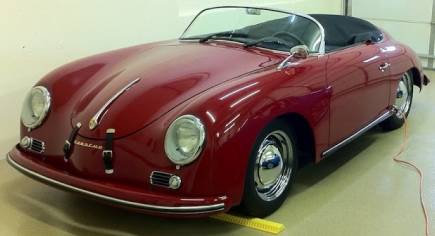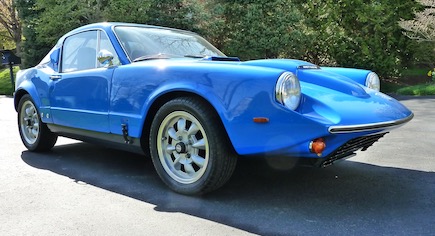Alignment
The electric 356 is about 200 lbs(1) heavier than its gasoline sibling, so to replicate the handling of the 1957 original as well as minimize tire friction, additional alignment precision is warranted.
In the 1950's, before electronic alignment technology like the Hunter equipment pictured below, mechanics simply used tape measures and levels. With electronic measurements, greater accuracy can properly compensate for the different weight distribution of the lithium battery packs. Test drives show that alignment improves efficiency (miles per charge) by about 10%.

Hunter system positioned on the front wheel
The 1957 Porsche 356 used a swing axle suspension in the rear where the camber, or vertical tilt, of the wheel is dependent upon the ride height of the vehicle.
Our original prototype plan called for coil-over shocks to handle the heavy battery packs, but these caused an excessively high ride height, resulting in a positive (and dangerously incorrect) rear wheel camber, so standard shocks are now installed (no coil-over spring).
Reverting back to standard shocks made it possible to achieve an adjusted alignment for classic 356 handling characteristics.
ALIGNMENT SPECIFICATIONS
- FRONT - negative 0.30 camber, 1/8” total toe in
- REAR - negative 0.80 camber, 1/16” total toe in
FOOTNOTE
1. Weight differential calculated by offsetting 90 lbs full gas tank plus 290 lbs dressed 1600cc engine against 445 lbs battery pack and 135 lbs motor/controller assembly; difference is 200 lbs
The Cars
Porsche 356 Speedster

The iconic Porsche Speedster proved to be an excellent EV conversion candidate due to its low weight, relatively simple design, and ample front/rear compartments for mounting pristmatic lithium battery cells. Weight distribution was improved over the original rear engine configuration with better acceleration and overall performance.
Saab Sonett

The unusual fiberglass Sonett, originally powered by a Ford V4 engine, combines a low center of gravity and front wheel drive, optimal for our high performance EV conversion. Without the need to accomodate a long drive train, the space behind the two seats was used for additional batteries. The original four-speed transmission remains intact along with the braking system.